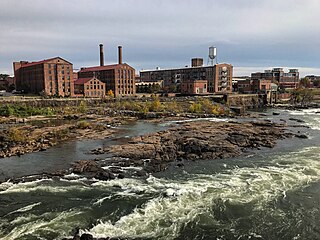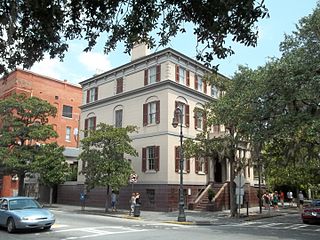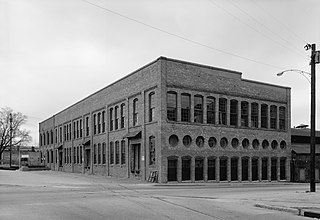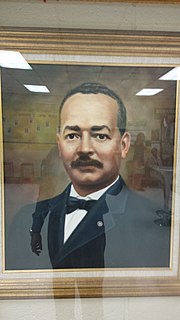
Muscogee County is a county located on the central western border of the U.S. state of Georgia; its western border with the state of Alabama is formed by the Chattahoochee River. As of the 2010 census, the population was 189,885. Its county seat and only city is Columbus, with which it has been a consolidated city-county since the beginning of 1971.

Columbus is a consolidated city-county located on the west-central border of the U.S. state of Georgia. Columbus lies on the Chattahoochee River directly across from Phenix City, Alabama. It is the county seat of Muscogee County, with which it officially merged in 1970. Columbus is the second-largest city in Georgia, and fields the state's fourth-largest metropolitan area. At the 2020 census, Columbus had a population of 206,922, with 328,883 in the Columbus metropolitan area. The metro area joins the nearby Alabama cities of Auburn and Opelika to form the Columbus–Auburn–Opelika Combined Statistical Area, which had an estimated population of 486,645 in 2019.

Sautee Nacoochee is a census-designated place in White County, Georgia, United States, near Sautee Creek in the Appalachian foothills of northeast Georgia, approximately 95 miles (153 km) north of Atlanta. The nearest incorporated town is the tourist destination of Helen.

The Georgia Trust for Historic Preservation is the United States' largest statewide, nonprofit preservation organization with more than 8,000 members. Founded in 1973 by Mary Gregory Jewett and others, the Trust is committed to preserving and enhancing Georgia's communities and their diverse historic resources for the education and enjoyment of all.

The Octagon House, also known as May's Folly, is a historic octagon house at 527 1st Avenue in Columbus, Georgia. Built about 1830 and enlarged in 1863, it is claimed by the local historical society to be the nation's only known example of a double-octagon house. It was declared a National Historic Landmark in 1973.

The Taylor-Grady House, also known as the Henry W. Grady House, is a historic house museum and National Historic Landmark at 634 Prince Avenue in Athens, Georgia, United States. Built in the 1840s, this Greek Revival house is notable as the only known surviving home of Henry W. Grady (1850–89), managing editor of the Atlanta Constitution and a leading force in the reintegration of the American South in the Reconstruction Era that followed the American Civil War. The house is operated by the Junior League of Athens, which offers tours and rentals for private events.

Juliette Gordon Low Historic District consists of three buildings—the Juliette Gordon Low Birthplace (also known as Wayne-Gordon House, First Girl Scout Headquarters, which was the carriage house for the Andrew Low House, converted for use by the Girl Scouts in May–June 1912, and said Andrew Low Carriage House, is a site in Savannah, Georgia, significant for its association with Juliette Gordon Low and the founding of the Girl Scouts of the USA.

The Robert Toombs House State Historic Site is a historic property located at 216 East Robert Toombs Avenue in Washington, Georgia. It was the home of Robert Toombs (1810–85), a U.S. representative and U.S. senator from Georgia who originally opposed Southern secession but later became a Confederate Cabinet official and then a Confederate general during the American Civil War. Operated as a state historic site, the 19th-century period historic house museum features exhibits about the life of Toombs. The house was declared a National Historic Landmark in 1973.

Downtown Columbus, Georgia, also called "Uptown", is the central business district of the city of Columbus, Georgia. The commercial and governmental heart of the city has traditionally been toward the eastern end of Downtown Columbus, between 10th Street and 1st Avenue. Recent developments, particularly between Broadway and 2nd Avenue, have expanded the boundaries of the "central" part of the neighborhood. The term "Downtown Columbus" can also mean this smaller, more commercial area, particularly when used in the context of the city's nightlife and restaurants

Midtown is an area of six square miles in Columbus, Georgia. Within its boundaries are residential neighborhoods, historic districts, eleven public schools, parks and public greenspaces, the Columbus Museum, the Columbus Public Library, the Muscogee County Public Education Center, the Columbus Aquatic Center, commercial office and retail districts, and the international headquarters for Aflac. Midtown is home to over 22,000 residents living in 8500 households and is six miles (10 km) north of Fort Benning on I-185.

Columbus Historic District in Columbus, Georgia is a historic district that was listed on the National Register of Historic Places in 1969. Its area was increased in 1988. The original district included 20 city blocks and nine partial city blocks, and was bounded by the Chattahoochee River on the west, Ninth Street on the north, Fourth Avenue on the east, and Fourth Street on the south.

The Columbus Ironworks was built in 1853. It was listed on the U.S. National Register of Historic Places in 1969. During the Civil War, the industrial plant produced weapons for the Confederate army. These weapons included cannons, pistols, rifles, and swords.

William Henry Spencer was an Afro-American educator in Columbus, Georgia, in the late 19th and early 20th century.
The Colored Cemetery on 10th Avenue in Columbus, Georgia, is a 17.6-acre (7.1 ha) cemetery used by African-American citizens of Columbus that has burials dating back to at least the 1840s. In 1936, the name Porterdale Cemetery began to be used also. It is believed to have been included in the 1828 plan for the city by surveyor Edward Lloyd Thomas.

Edward Lloyd Thomas, Sr. (1785–1852) was a Methodist preacher, a land speculator, and a surveyor in Georgia, United States. He had six brothers and a sister. Among his children was Confederate general Edward Lloyd Thomas (1825–1898).
Frederick Roy Duncan, often known as F. Roy Duncan, was an engineer and architect. His architectural practice was based in Columbus, Georgia, where he was born in 1886 and where he is buried.
The following is a timeline of the history of the city of Columbus, Georgia, US.
The Building at 1619 Third Avenue in Columbus, Georgia is a Victorian shotgun cottage built around 1889 which was listed on the National Register of Historic Places in 1980.
The Building at 1519 3rd Avenue in Columbus, Georgia was built c.1908-10. It was listed on the National Register of Historic Places in 1980.

The Lion House, also known as the Hoxey–Cargill House, is a historic building in Columbus, Georgia. The building, located in the High Uptown Historic District, was built in the 1840s and was added to the National Register of Historic Places in 1972.

















